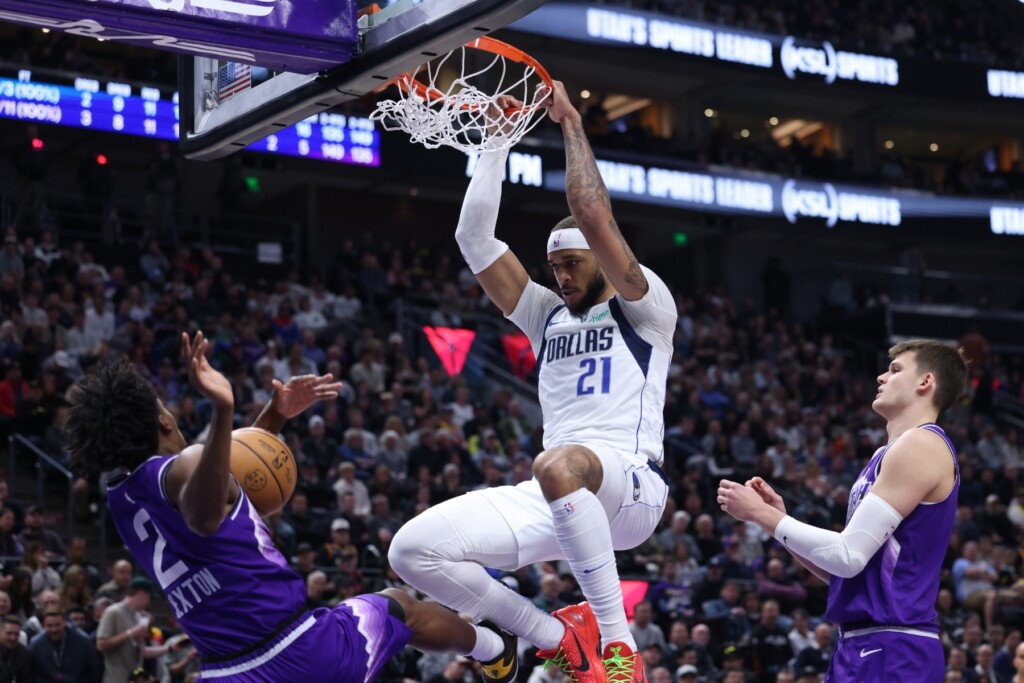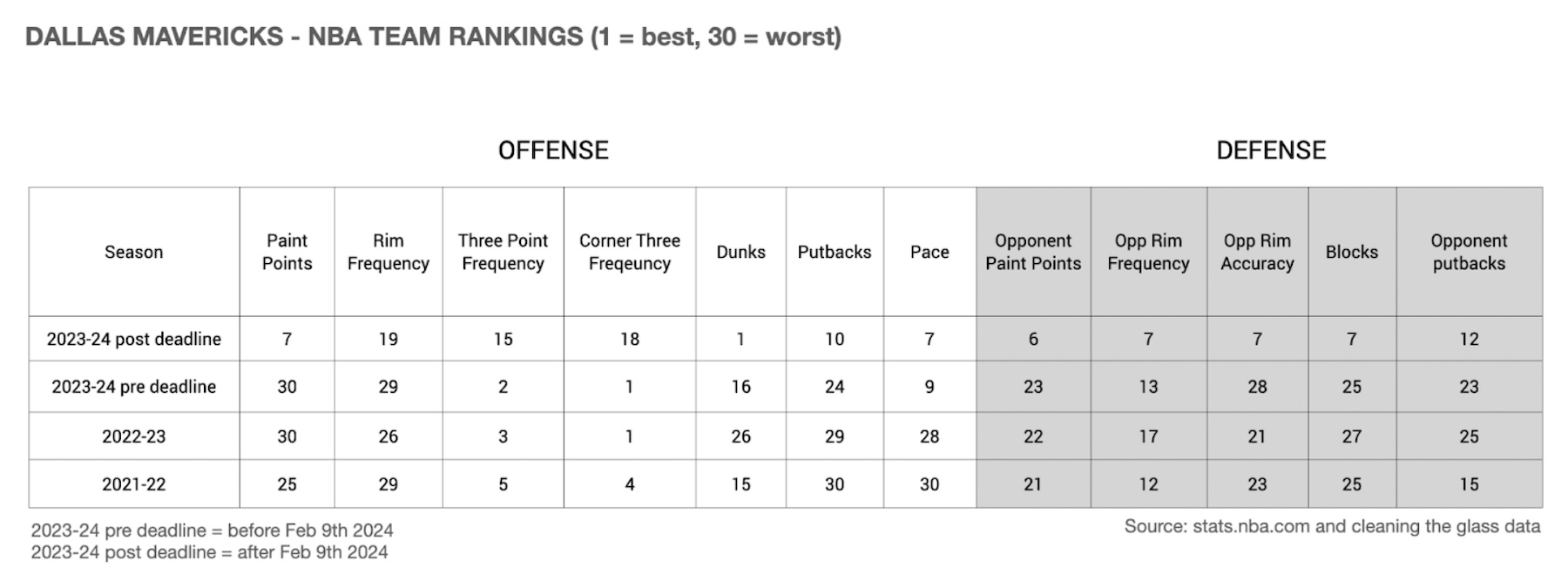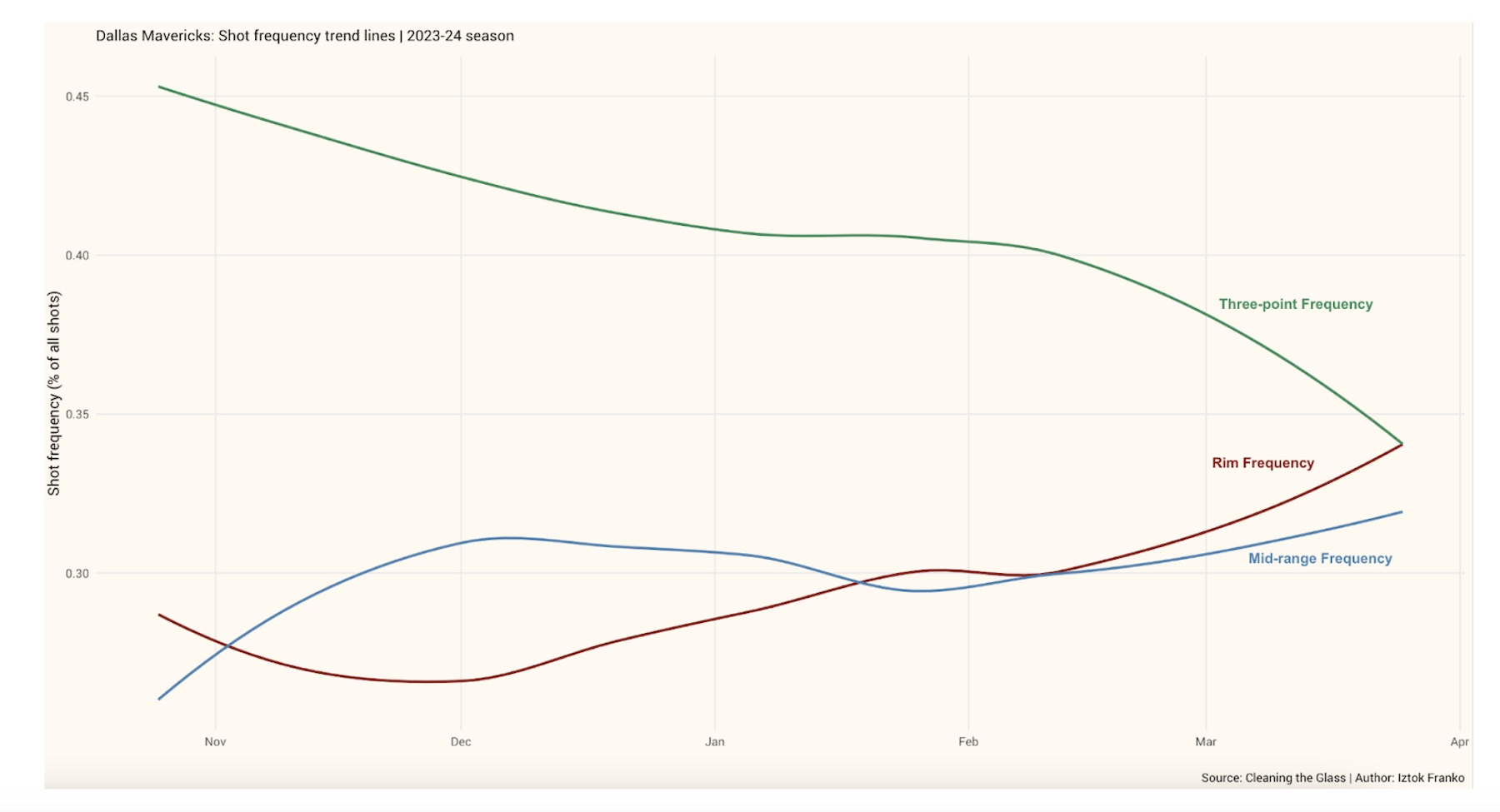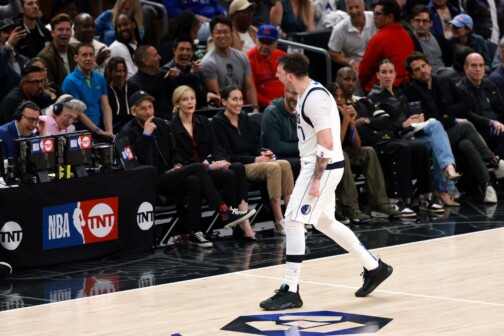For someone who has closely followed and covered the Mavericks ever since they drafted Luka Dončić in 2018, I am having a hard time comprehending the team we’ve been watching since the trade deadline. For five years, we observed various iterations of the same template: a relatively small team with some shooting around Dončić’s otherworldly talents, which enabled him to function as a methodical half-court surgeon. They played deliberate basketball, spreading out opponents by playing five-out, pick-and-rolling defenses to death, and punishing any collapse on Dončić by hitting a ton of threes.
Now, however, we’re in uncharted territory. Over the last 19 games, we’ve watched something entirely different: a team winning with size and speed instead of precision and patience. A team that feasts at the rim, rather than bombing from downtown. A team that almost broke the rims in the American Airlines Center last Thursday when it blew out the Utah Jazz, 113-97, while putting up a franchise-record 18 dunks.
While this new brand of basketball is undoubtedly more entertaining to watch, the logical question is: how far can this new style take the Mavs? Starting tonight, we’ll get two big measuring-stick games to evaluate, in an almost playoff-like setup, against one of the teams the Mavs are fighting for the coveted sixth spot in the Western Conference—the Sacramento Kings. Plus, it’s a chance to settle old scores; the Kings are one of the teams that most took advantage of the smaller Mavericks, beating them twice this season by pushing them around in the paint.
But before we get there, let’s analyze how much these Mavericks have really changed.
The data suggest a total makeover, yet this change didn’t happen overnight. Glimpses of this new approach were visible early in the season, even before the trade-deadline acquisitions of Daniel Gafford and P.J. Washington. The transformation began in the offseason, with the drafting of big man Dereck Lively II and two under-the-radar signings: Derrick Jones Jr. and Dante Exum. Buried under a slew of injuries and the disappointment surrounding the biggest summer acquisition, Grant Williams, was a blueprint for the transformation. That prompted me to write before the trade deadline: “Good things happen when you surround Dončić with long, athletic players who can defend, handle the ball a bit, and attack the rim.”
At the deadline, general manager Nico Harrison doubled down on that blueprint, adding even more size, length, and athleticism to the frontcourt. Harrison’s roster reshuffling has allowed Jason Kidd to return to his vision when he took the job: prioritizing size with a focus on defense. It’s a model Kidd saw succeed when he was Frank Vogel’s assistant on the Los Angeles Lakers’ championship team, and one he implemented early in Dallas by deploying big starting lineups featuring Kristaps Porzingis at the power forward spot, alongside Dwight Powell and Dorian Finney-Smith in the frontcourt. Ever since the Porzingis trade in February 2023, Kidd, touted as a defense-first coach, leaned into playing small, focusing on offense and three-point shooting. To be fair, in most cases, he didn’t have the personnel to do things differently. Now he has the size to revert to the original plan, but with one major difference: this roster boasts not just size but also speed and athleticism.
After an initial adjustment period following the trades for Washington and Gafford and a disappointing stretch over which the Mavericks lost five of six games, Kidd reshuffled his starting lineup, inserting Gafford and Jones alongside Dončić, Washington, and Kyrie Irving. More than that, he went all in on defense, playing defensively minded Exum, Lively, Josh Green, and Maxi Kleber as his first four subs off the bench, which led to sporadic minutes for smaller and limited defenders Tim Hardaway Jr. and Jaden Hardy. This change, of course, completely altered the team’s profile, transforming the Mavericks from a high-volume three-point-shooting team with a porous interior defense into a paint-attacking and paint-patrolling juggernaut.
It’s remarkable how, almost overnight, the Mavericks have ascended in every category related to paint and rim pressure both defensively and offensively, after languishing at the bottom of the league in these areas for the last few years. Even if you’re not a stats nerd like I am, you must acknowledge how fun it is watching the highlight reel of blocks, lob dunks, and up-tempo, high-paced basketball.
Earlier in the season, the Mavericks transitioned from a walk-it-up-the-floor team to one that plays at a high tempo. Similarly, becoming a high-volume paint-attacking team was something I never expected to see from a Dončić-led offense. Like pace, rim frequency and paint points were two areas in which the Mavs were bottom five in each season since Dončić’s rookie year. This transformation is not just a testament to the athleticism now surrounding him, but also another showcase of Dončić’s brilliance—being able to utilize whatever talent is around him.
Minutes that used to go to spot-up shooters and corner three specialists including Finney-Smith and Reggie Bullock, as well as Williams, Hardaway Jr., and Seth Curry earlier this season, have been replaced by Gafford, Lively, Exum, and Jones Jr., players whose first and sometimes only option is to attack the rim. Surround Dončić with shooters and the Mavs will be at the top of the league in corner-three frequency. Insert athletic big men and they’ll lead the NBA in dunks. Gafford, in particular, is flourishing alongside Dončić. In the 19 games since his arrival, he is averaging almost 12 points per game with an absurd 78 percent field goal percentage. For context, Gafford led this category with a 69 percent rate as a Wizard before joining the Mavs. Since February 9, Dallas ranks second in the NBA, trailing only the Los Angeles Lakers, in pick-and-roll actions that resulted in a screener’s shot at the rim.
The Mavericks, who were historically dependent on three-point shots going in, are finding new ways to win. In a recent stretch with the new starting lineup, over which they have won eight of their last nine games, Dallas has shot just 32 percent from beyond the arc, and won six of those games shooting 33 percent or worse. The new Mavericks way was on full display during two of the most impressive wins in this stretch, against the Denver Nuggets and Miami Heat, the two teams who squared off last year for the NBA championship. What used to be considered a finesse team won both games by out-hustling and being longer and more athletic than its opponents—two of the most physical teams in the NBA. When Nikola Jokić, one of the strongest interior operators in the NBA, takes notice of your size, you know you’re onto something. The Mavericks’ bigs didn’t out-muscle Jokić—nobody in the NBA does—but they made him work hard by pressuring the rim, sprinting to the rim in transition, and leveraging their athleticism to out-jump him for offensive rebounds.
Now, the transformation does come at a cost.
Shooting is the main concern, potentially the Mavericks’ kryptonite on both ends of the floor, something that good teams will continue to exploit. The playoff-like matchups against the Kings will serve an opportunity to stress-test the weak spots.
Offensively, playing more lineups featuring poor shooters—like a starting lineup with Washington and Jones Jr.—alongside a non-shooting big in Gafford or Lively, results in suboptimal spacing and entices good defensive teams to be more aggressive with their help rotations. On Monday night, the Utah Jazz used Lauri Markkanen to help off Washington and Jones Jr., providing early low-man help on rolls and drives. While Dončić is creating plenty of easy scoring opportunities for his big men, Second Spectrum tracking data indicate that his own shot quality plummets when playing with the new starting frontcourt. This puts additional pressure on Dončić and Irving to make difficult shots, a task they are certainly capable of, but it’s not ideal for offensive efficiency.
Another tactic teams most likely will employ, as the Kings have done in past matchups and may repeat this week, is defending the Mavericks’ bigs with a wing while assigning their center (Domantas Sabonis in the Kings’ case) to guard Jones Jr. or another player perceived as the least dangerous option on the floor. This enables teams to switch more frequently, diminishing the impact of rolling lob threats and pushing Dončić and Irving toward isolation basketball. Slower pace, more switching, fewer rolls to the rim, more isolation plays leading to a notable decrease in rim frequency, and a rise in midrange and three-point frequency are hallmarks of playoff-style basketball. This is also why, despite the recent success of playing big, I expect we’ll still see lineups featuring Kleber and Washington.
The other factor reinforcing this expectation lies on the defensive end of the floor. The Mavericks’ scheme is built on protecting the paint at all costs. This is why we often see the bigs sagging off of an opponent’s bad shooters, rotating or front-loading when defending off the ball, or in drop or ice coverage when defending the pick-and-roll. It’s also the main reason why the rim and paint defense numbers have improved so significantly. The Mavericks have had success with this approach against teams with at least one weak link to scheme their help around.
But this tactic can be exposed by teams that have bigs who can stretch the floor—recent struggles against Porzingis and Myles Turner come to mind—or good shooting teams with crisp ball movement, and ball handlers who can attack and hit the midrange shot against bigs trying to protect the rim. (Take, for example, Denver with Jamal Murray, Oklahoma City with Shai Gilgeous-Alexander, and Sacramento with De’Aaron Fox.) In these cases, unless Gafford and Lively can dominate the offensive glass as they did against the Nuggets, the most logical counter remains the defensive combo of Washington and Kleber, who are more agile and switchable than their bigger teammates.
With only 11 games left in the regular season, these next two against the Kings could reveal a lot. It’s an opportunity for the beefed-up Mavs to show they won’t be pushed around anymore. Sabonis shot 18 of 21 in the paint in the first two matchups this season, while the Kings collectively shot 67 percent in the paint. Similar to Jokić, the Dallas centers won’t overpower Sabonis, but they must utilize their length and athleticism to make him exert himself on both ends of the floor. Sabonis will not be the only problem; the Sacramento offense is cohesive, and the Kings have had countless reps running Mike Brown’s high-paced half-court system. They don’t have a clear weak link, they feature plenty of movement with handoffs and second-side actions, and they have a midrange assassin in Fox. It will be another litmus test to gauge just how legitimate these new-look Mavericks really are.
Buckle up.
Author









